This EDIS publication, focusing on the general public perceptions of endangered species, is the first of a two-part EDIS publication series. The series aims to help Extension faculty understand public perceptions of endangered and invasive species and use this new understanding in their programming with clientele. This series includes the following publications:
- Floridians' Perceptions of Endangered Species
- Floridians' Perceptions of Invasive Species
Introduction
Florida is one of the most species-rich states in the nation (Rocus and Mazzotti 2014), with abundant and unique plants and animals that make it a biodiversity hotspot in the United States (Cameron Devitt et al. 2012). The state's biodiversity and natural systems serve as the basis for important industries including tourism, recreation, and fisheries. In 2012, tourists visiting Florida spent $71.8 billion, contributing to the state economy (Visit Florida 2013). In addition, hunting, fishing, and wildlife viewing activities contribute over $21 billion in annual economic impact in the state (Florida Fish and Wildlife Conservation Commission [FWC] 2014b).
But the value of Florida's species and natural systems extends beyond their economic impact; they provide an array of vital ecosystem services that benefit Florida residents, including filtering pollution, protecting property, recharging the Floridan aquifer, purifying air, protection from floods, cycling of nutrients, sequestering carbon, and stabilizing climate, to name just a few (Johns et al. 2013; Mazzotti 2014). Despite the clear value of the state's biological resources, a range of human activities contribute to biodiversity loss including habitat degradation, fragmentation and destruction; overharvesting; climate change; and invasive species introductions (Rocus and Mazzotti 2014; United States Fish and Wildlife Service [USFWS] 2005). Unfortunately, Florida also stands out in the high number of species at risk of decline and extinction as a result of these activities. Only Alabama, California, and Hawaii have more listed endangered and threatened species than Florida (USFWS n.d.). Florida is currently home to 42 animal species and 46 plant species that are federally listed as endangered species (USFWS n.d.). Endangered species of plants and animals are of esthetic, ecological, educational, historical, recreational, and scientific value to Americans (USFWS 2005).
Due to concerns over species decline and extinction, several laws and acts were implemented in the early to mid-1900s, but it was not until 1973 that the strongest and most important federal law protecting species was passed: the Endangered Species Act (ESA)(Bowden, Lamm, Irani, and Galindo 2013). The main purpose of the ESA is to protect species and also the ecosystems upon which they depend. The ESA is administered by the U.S. Fish and Wildlife Service and the National Marine Fisheries Service.
Enhancing and conserving Florida's natural resources and environmental quality is a priority initiative of the UF/IFAS Florida Cooperative Extension Service. Therefore, the role Extension faculty play in helping the public understand Florida's natural resources, including endangered species and the threats to them, is important and contributes to the success of this initiative. This information also can be used to help communities respond to natural resource challenges statewide.
This EDIS publication can help Extension faculty understand Florida residents' perceptions, knowledge and attitudes about endangered species. This understanding can equip Extension faculty to more effectively communicate with and educate clientele about this topic.
Background
The UF/IFAS Center for Public Issues Education in Agriculture and Natural Resources (PIE Center) initiated a study to explore the attitudes, perceptions, opinions, and knowledge of Floridians on endangered and invasive species. In July 2014 an online survey was distributed to a representative sample of Florida residents using non-probability sampling. The survey was distributed to Florida residents 18 and older, and 515 completed responses were collected (Odera and Lamm 2014). To ensure that respondents were representative of the 2010 U. S. Census, the data were weighted to balance their geographic location in the state, age, gender, and race (Kalton and Flores-Cervantes 2003).
Results
In order to understand perceptions, knowledge, and opinions of endangered species, respondents were asked questions about their overall knowledge of endangered species, knowledge of policies and activities affecting endangered species, level of interest in news on endangered species, interest in topics related to endangered species, and preferred modes of learning. The majority of respondents have favorable views of endangered species but few consider themselves knowledgeable on the issue.
Overall Knowledge
To examine their overall knowledge about endangered species, respondents were given several topics and asked to indicate their level of knowledge on a five-point scale (1 = Not knowledgeable, 2 = Slightly knowledgeable, 3 = Fairly knowledgeable, 4 = Highly knowledgeable, and 5 = Extremely knowledgeable). More respondents considered themselves fairly to extremely knowledgeable about threats to endangered species (56 percent) than about how to prevent the endangerment of species (49 percent) or what species are endangered (45 percent) (Figure 1).
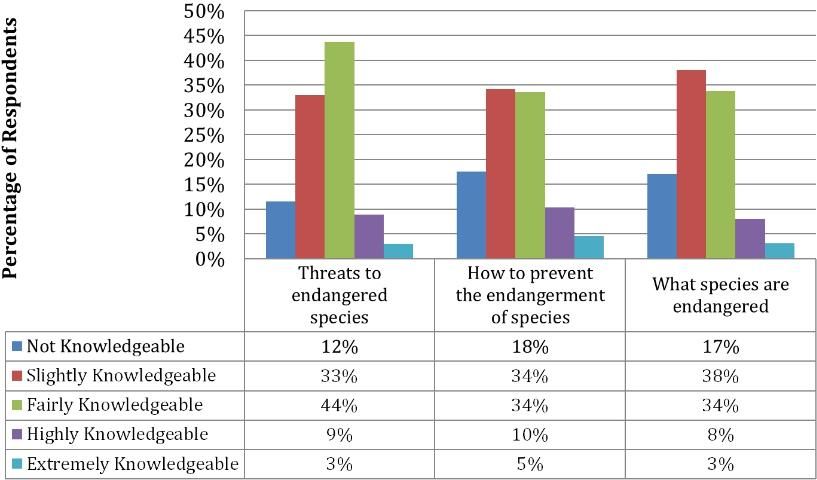
Contributors to Species Endangerment
To examine knowledge of contributors to species endangerment, respondents were given a list and asked to indicate the contributor they believe was the most important to species endangerment. Almost half (46 percent) chose "habitat loss" as the greatest contributor to species endangerment, with the other choices falling far behind (Figure 2).
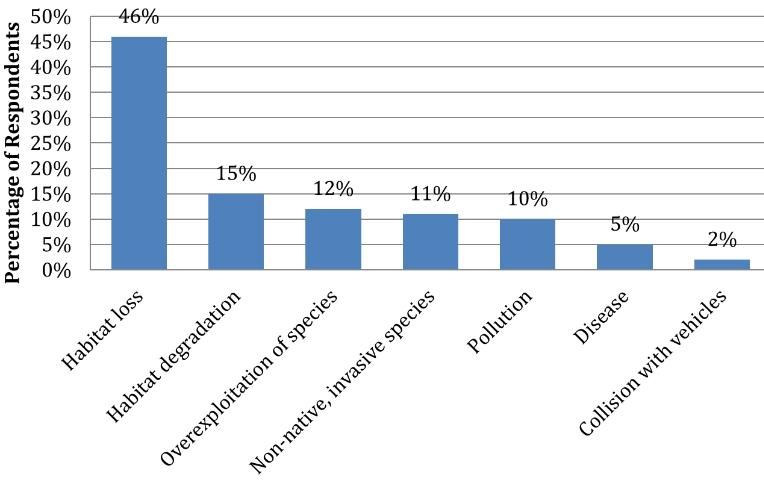
Endangered Species Act (ESA)
To examine public opinion of the ESA, respondents were given the following question: "The Endangered Species Act was enacted in 1973 to provide conservation for species that are endangered or threatened, as well as the conservation of their ecosystems." Respondents were then asked whether the U.S. ESA should be a) revoked, b) weakened, c) unchanged, d) strengthened, or e) no opinion. Fifty-five percent of the respondents believed the Endangered Species Act should be strengthened (Figure 3).
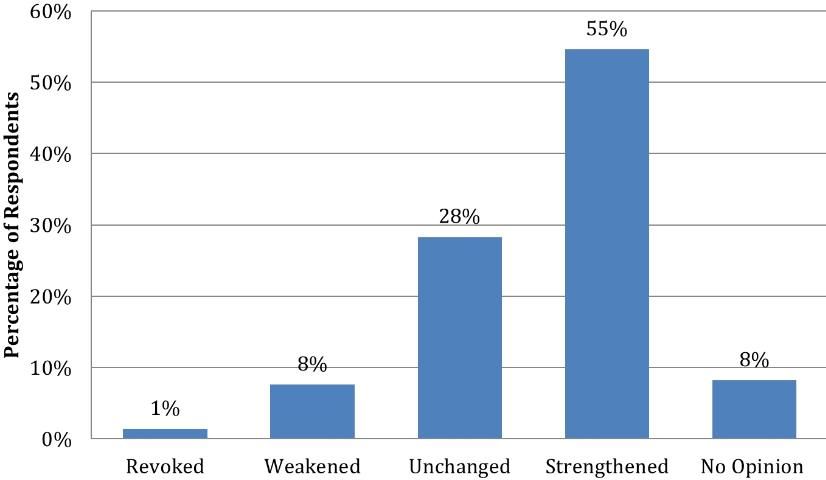
News Interest
To examine interest in news articles about endangered species, respondents were given the following question: "How likely are you to pay attention to a news story dealing with issues related to endangered species?" and asked to indicate their likelihood on five-point scale (1 =Very Likely, 2 =Unlikely, 3 = Undecided, 4 = Likely, and 5 = Very Likely). Eighty-two percent were likely or very likely to pay attention to an endangered species news article (Figure 4).
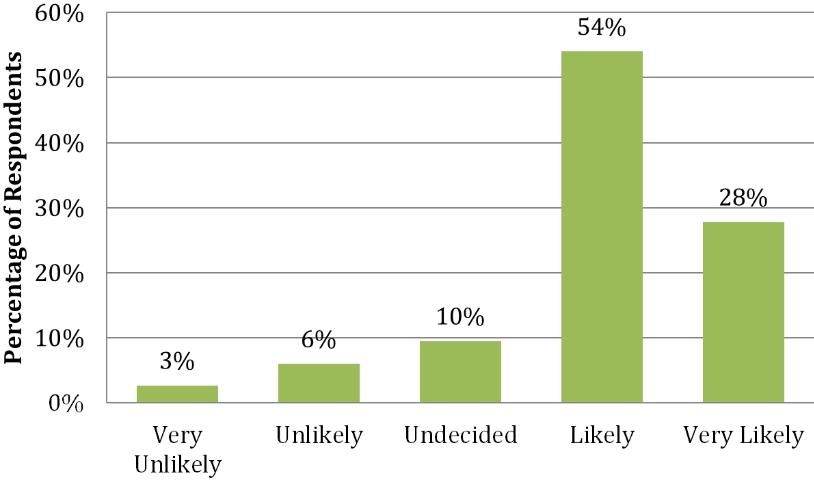
Educational Topics and Learning Mode
Respondents were asked to indicate what topics related to endangered species they would like to learn more about. Seventy percent of respondents would like to learn more about types of species that are endangered (Figure 5). Fifty-four percent would like to learn about protection strategies for endangered species (Figure 5).

Next, respondents were asked about the type of learning opportunities they would be most likely to take advantage of when learning about endangered species topics. They were presented with a list of options and asked to check all that apply. The most popular preferred modes of learning for endangered species topics were through watching TV coverage (88%), visiting a website (87 percent), and watching a video or reading printed fact sheets, bulletins, or brochures (86 percent) (Figure 6).
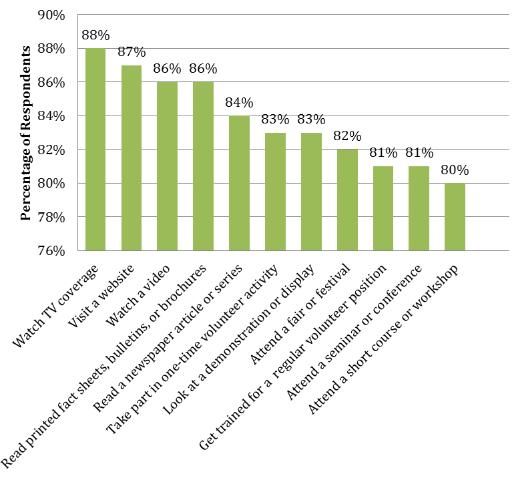
Recommendations
The survey responses revealed that Floridians do not consider themselves to be very knowledgeable about endangered species. However, there is a high level of interest in learning more about endangered species, specifically through viewing news stories on endangered species and watching TV coverage of endangered species. This self-reported low level of knowledge paired with a high level of interest in learning presents a unique opportunity for Extension and state agency education efforts. Both should consider developing media campaigns to deliver information on endangered species, particularly types of endangered species and strategies for their protection.
Alternatively, Extension faculty should consider developing a joint campaign with a state agency that could build a strong collaboration between partners to emphasize what species are endangered and efforts the public could engage in to protect endangered species, furthering both organizational missions. Considering that respondents were most interested in news stories and TV coverage, these modes of communication should be emphasized throughout the campaign. Specifically, Extension faculty looking to educate about endangered species should develop plans to engage the media and highlight important aspects of the endangered species issue.
Extension faculty also can incorporate information about endangered species into existing programming focused on natural resources and youth education. Extension faculty may want to consider new venues to relay information about endangered species. For example, parks, museums, and botanical gardens may be locations more conducive to talking about plants, animals, and natural systems. At these programs, additional information about endangered species could best be relayed through a website, video, or printed fact sheets, bulletins, or brochures. Should these opportunities occur, Extension faculty are encouraged to capture their presentations on video for use in TV programming, thereby reaching an even larger audience.
References
Bowden, C., A. Lamm, T. Irani, and S. Galindo. 2013. "A cooperative agreement and the implementation of Endangered Species Act: How extension can facilitate stakeholder involvement and compliance." WC141. Gainesville: University of Florida Institute of Food and Agricultural Sciences. https://doi.org/10.32473/edis-wc141-2013
Cameron Devitt, S., J. Seavey, S. Claytor, T. Hoctor, M. Main, O. Mbuya, and C. Noss. 2012. Florida biodiversity under a changing climate. Florida Climate Task Force. http://www.ces.fau.edu/publications/pdfs/BiodiversityWhitepaper.pdf. Accessed August 24, 2022.
Florida Fish and Wildlife Conservation Commission. 2014a. "Imperiled Species." https://myfwc.com/wildlifehabitats/wildlife/. Accessed August 24, 2022.
Florida Fish and Wildlife Conservation Commission 2014b. "Overview—Fast Facts." https://myfwc.com/about/overview/
Johns, G., C. Kelble, D. Lee, V. Leeworthy, W. Nuttle. 2013. Ecosystem services provided by the South Florida coastal marine ecosystem. Marine and Estuarine Goal Setting for South Florida. White paper. https://www.aoml.noaa.gov/ocd/ocdweb/docs/MARES/MARES_WhitePaper7_ESprovidedBySFCME_20130420.pdf. Accessed August 24, 2022.
Kalton, G. and I. Flores-Cervantes. 2003. "Weighting methods." Journal of Official Statistics 19(2):81–97.
Mazzotti, F. 2014. "The value of endangered species: The importance of conserving biological diversity." SSWIS14. Gainesville, FL: University of Florida Institute of Food and Agricultural Sciences. https://edis.ifas.ufl.edu/publication/uw064
Odera, E. and A. Lamm. 2014. "Public opinion of endangered and invasive species in Florida." PIE2012/13-13. Gainesville, FL: University of Florida Institute of Food and Agricultural Sciences Center for Public Issues Education. http://www.piecenter.com/wp-content/uploads/2014/08/Endangered__Year2_ReportFINAL.pdf
Rocus, D. and F. Mazzotti. 2002. "Threats to Florida's Biodiversity." SSWEC70. Gainesville: University of Florida Institute of Food and Agricultural Sciences. https://edis.ifas.ufl.edu/publication/uw107.
U. S. Fish and Wildlife Service. n.d. Environmental Conservation Online System. https://ecos.fws.gov/ecp/report/species-listings-by-state?stateAbbrev=FL&stateName=Florida&statusCategory=Listed. Accessed August 24, 2022.
U.S. Fish and Wildlife Service. 2005. Why Save Endangered Species? https://www.fws.gov/sites/default/files/documents/Why-Save-Endangered-Species-Brochure.pdf. Accessed August 24, 2022.
University of Florida Institute of Food and Agricultural Sciences Extension. 2013. Shaping solutions for Florida's future: The UF/IFAS extension roadmap 2013–2023. https://pdec.ifas.ufl.edu/roadmap/FloridaExtensionRoadmap_2013-2023.pdf. Accessed August 24, 2022.
Visit Florida. 2013. 2012–2013 Annual Report. Retrieved from https://www.visitflorida.org/media/7969/yearinreview2013.pdf. Accessed August 24, 2022.